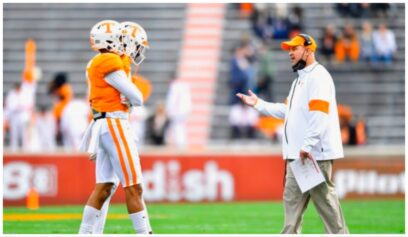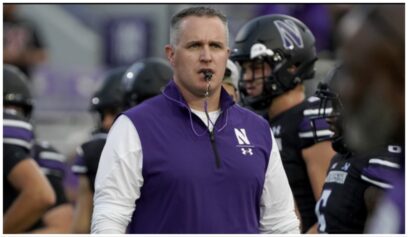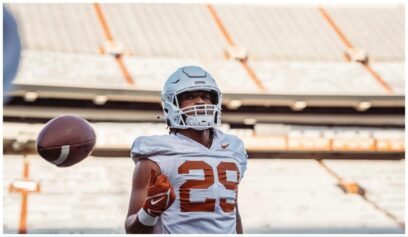This is Part 2 of a two-part series on ESPN’s "30 for 30" feature, The U: Part 2.
Produced in 2009 by ESPN for its "30 for 30" series, "The U" was a look at all that was boiled eggs and gravy about the rise of the University of Miami's football program in the 1980s. But the saga didn’t end there.
The U: Part 2 which airs tonight at 9pm ET on ESPN, elaborates on the original film directed by Miami alum Billy Corben and picks up with the program trying to recover from the devastation left by media hounding, NCAA sanctions and scandals that had some calling for the school to chuck the program.
The Hurricanes bounced back like a rubber band to win another national championship with swagger in 2001, only to face new controversies when a booster used a Ponzi scheme to win favor with the program.
Throughout the 1980s, Miami, Fla., was at the center of a racial and cultural shift that shook the country. Three dangerous fronts collided in Miami. The explosion of public violence from the Cocaine Wars, the influx of thousands of criminal Cuban refugees during the Mariel Boatlift and deadly race riots following the acquittal of Miami-Dade police officers who beat a black insurance salesman to death.
Riots, tension and the rising Colombian drug trade made Miami a contradictory hotbed for the wickedest pitfalls and The American Dream. The University of Miami’s football team served as a microcosm for this evolution.
The image of the predominantly white university was forever changed when HC Howard Schnellenberger scoured some of the roughest ghettos in Florida to recruit mostly black players for his team.
Schnellenberger was on some Nick Nolte in Blue Chips mission.
He didn’t care about academic standards, perceived cultural flaws, skin color or the opinion of “the establishment.” He knew where to find those athletes that could execute his vaunted offensive schemes to perfection. He was prepared to roll the dice on a dynasty by infiltrating Miami’s precious university with the lost sons of that city.
Guys who appreciated the opportunity to play college football on a grand stage in front of friends and family.
Young men who have lived on the flip side of the glitz and glamour of hotels, captivating night life and high rise office buildings that turned downtown Miami into a contractors dream and Metropolitan paradise. Schnellenberger plucked the salvageable soldiers of hope from the hoods of destitution and inevitable failure and put them right smack in the middle of a cultural and athletic revolution.
With a newly branded swagger, inspired and fueled by the quickly growing local Miami hip-hop culture, these Hurricanes took on mythical personalities and won four national titles between 1983 and 1991 (1983, 1987, 1989, 1991).
They were not the steeped-in-tradition, cookie cutter, choirboys of Notre Dame, but they were the “new” Miami’s hometown heroes and reflected the temperature of the city.
Miami was off the chain at that time. The popularity of Miami Bass—once a style of music indigenous to Floridians and Southerners—spread throughout hip-hop’s vast underground network and became the soundtrack which defined the “We Don’t Give a Fuck, Life Is a Party” attitude of the Miami football team.
Stories about the team’s shenanigans during that golden era are often overrated by Miami haters.
But some stories concerning “illegal” activity and an all-out wild, wild west atmosphere facilitated by celebrities like rap star Luke—who was known to be a huge presence at Miami games and reportedly used to pay players monetary and sexual favors as a reward for tackles, touchdowns, concussions and cart-offs—seems possible.
The popularity of the musical genre and the team grew simultaneously. As did the negative national attention from “80’s conservative types” who targeted the explicit content and violent imagery in these songs and made them an extension of the perceived character of every player on that Miami team—especially the poor black kids.
Many of those risks turned out to be highly productive men who used their opportunities at The “U” to go on and accomplish great things as professional athletes, entrepreneurs and analysts.
Check these figures about Miami players and their NFL presence over the years. For all of the controversy and scandal that has accompanied this university’s meteoric rise as a national force in college football, the NFL hasn’t played shy at draft time.
The Canes hold the record for most players selected in the first round in a single draft (6, in 2004), most first-round draft picks in a two-year period (11, from 2003 to 2004), most first-round draft picks in a three-year period (15, from 2002 through 2004), and most first-round picks in a four-year period (19, from 2001 through 2004).
For a 14-year period, from 1994 through 2008, Miami had at least one player selected in the first round of the NFL Draft, a NFL Draft record. The Miami Hurricanes are also 10th overall on the NFL's all-time number of draft picks with 315.
As of the 2014 NFL season, UM has the most players active in the NFL of any university in the nation, with, 46, including players on NFL Practice Squads and Injured Reserves and not including current Free Agents.
Miami players have left an indelible mark on the NFL. Jim Kelly, Michael Irvin, Vinny Testaverde, Cortez Kennedy, Warren Sapp, Jerome Brown, Jessie Armstead, Ed Reed, Bernie Kosar, Clinton Portis, Jeremy Shockey, Jon Vilma are just a few of the Canes who were products of a championship storm that feasted on the lily-white dorm rooms of America’s most prestigious universities and did it with a cultural impact similar to Michigan’s Fab Five.
The Miami Hurricanes brought street values and hood bravado into America's living rooms, but above all they specialized in football excellence and pushing the envelope while doing so.
Their endzone celebrations were the cocky blueprint and defiant origins for every excessive celebration flag that’s thrown in today’s emotionally-suffocating NCAA.
By the late 1980s the Miami Dolphins were no longer capturing the collective imagination of South Florida as they once had. The transformation was complete with the Hurricanes becoming the captivating, intimidating and controversial force of football dominance known as "The U."



